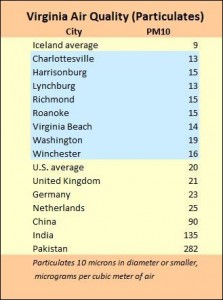 Ambient air pollution caused an estimated 3.7 million deaths worldwide in 2012, according to a recent report by the World Health Organization (WHO), while household air pollution, typically smoke from the use of coal, wood and dung in home cooking and heating, resulted in 4.3 million more.
Ambient air pollution caused an estimated 3.7 million deaths worldwide in 2012, according to a recent report by the World Health Organization (WHO), while household air pollution, typically smoke from the use of coal, wood and dung in home cooking and heating, resulted in 4.3 million more.
There are four main categories of air pollution, including ozone, nitrogen dioxide and sulfur dioxide but the deadliest is particulate matter, a complex mix of solid and liquid particles. The deadliest of these are the smallest ones, 1o microns in diameter or less. In March WHO published a database tracking the levels of sub-10 micron particulates in the ambient air of 1,600 cities around the world.
The cleanest cities in the world (with the lowest levels of particulates) would come as no surprise to those who follow the political geography of environmentalism. For the most part, they are Nordic or English-speaking countries, with Iceland, Canada and Australia at the top. The United States ranks 15th in the world (tied with Norway and the Maldives) but U.S. cities vary considerably in the cleanliness of their air. Despite being downwind from coal-fired power plants, Virginia cities are cleaner than the U.S. average. They may not be up to Icelandic standards — the country runs on geothermal energy — but they’re Gardens of Eden compared to major cities in India, China and the country with the worst particulate pollution in the world, Pakistan.
To peruse the WHO database, click here.
Bacon’s bottom line: Particulates are only one measure of air pollution but they are arguably the most important when it comes to public health. By this measure, Virginia cities are among the cleanest in the world. That’s not to say we’ve got the air pollution problem licked — ozone is still an issue — but when it comes to allocating resources, we probably can get a lot more bang for our buck concentrating on water quality, which is distressingly poor in the Old Dominion.
— JAB


